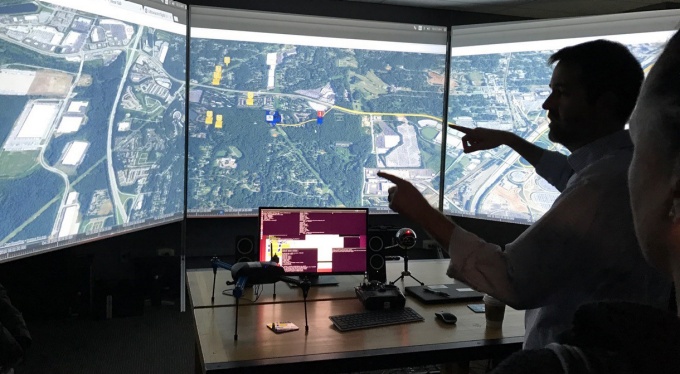Security and Defense
Our research improves the efficiency and effectiveness of security and defense systems.

Research in this area includes the development of solutions to optimize the use of sensor networks, including unmanned vehicles using operations research and data fusion methods, improved homeland security through the use of data fusion and game theory, and enhanced trust and decision-making performance in human-automation interactions with security and defense technology.
Sponsors include the National Science Foundation, US Department of Homeland Security, US Navy, USAF Research Laboratory, Defense Threat Reduction Agency Office of Naval Research, Army Research Laboratory Defense Intelligence Agency, US Space Force, Alion (AFRL-Rome), Sierra Nevada Corporation, Overwatch Systems, Raytheon C3 Systems and General Dynamics – AIS.
Affiliated Faculty
Selected Research Topics
Sensor Networks and Unmanned Vehicles
Sensors in a data fusion environment over hostile territory are geographically dispersed and change location with time. To collect and process data from these sensors, a flexible network of fusion beds (i.e., clusterheads) is required. The research focuses on modeling and solving problems that arise from multiple sensors working in a particular situation. Most of these problems occur in dynamic environments, where special methodologies are required.
Data Fusion and Homeland Security
Research projects focus on developing methods of enhancing national security and improving the accuracy of intelligence gathering. Information fusion works by combining evidence and intelligence gathered from a wide variety of sources, which when considered separately often yield conflicting and ambiguous results. The system combines and organizes the information from such sources as remote satellites, sensors, and individual personnel, and then incorporates it in a seamless flow to a central command center, where decisions can be more effectively rendered.
Game Theory and Homeland Security Resource Allocation
Hundreds of billions of U.S. dollars have been allocated to homeland security since 9/11/2001. How to optimally allocate these resources remains a challenging issue, especially considering the fact that adversaries are intelligent and adaptive. In this research, operations research and game theory are integrated to study the optimal defensive resource allocation. The tradeoffs between preparedness and relief, between efficiency and equity, and between private and public investment are also studied.
Information Visualization Research
A number of research projects have addressed the visualization of information relevant for command-and-control operations. Information may come from physical sensors with inherent uncertainty, different values may be provided by different sensors or sources, or future events or states may be difficult to predict. The relationships between information presentation methods including the use of graphical variables (color components, blurriness, and transparency) and multi-modal methods such sound and vibration, and human decision-making performance are studied.
Human Trust and Performance
Research in this area includes studies of trust in automated decision aids, particularly under circumstances where information provided by the aids has been degraded or corrupted. A focus of this work has been decision making in aided, adversarial situations, when decision aids include fused or processed information.
Airport Security
The research has integrated human factors, operations research and game theory to help authorities better prepare for, mitigate, and manage both natural and man-made hazards in systems such airport security systems. The emphasis thus far has been on the impact of humans and the available technologies on security system reliability and efficiency.